|
< Earlier Kibitzing · PAGE 2 OF 2 ·
Later Kibitzing> |
| Sep-18-10 | | RandomVisitor: 29.Qxc5 Bxe5 30.Bxe5 Qxd7 31.Bxb8 Rxg4 [Qd4] 32.Rd1 Qc6 33.Bxa7 Qxc5 34.Bxc5 Bc6 35.Rd6 might be winnable for white. |
|
| Sep-18-10 | | paul1959: <RandomVisitor> What Rybka's analysis show is that Black blundered with 41...a6xb5? This gave White three linked passed pawns and an easy win. After 38...e5 I would suggest 39.Be3 The idea is to force Black to lose time with Kf6. Material win is not important in such endings but the forward g pawn plays an important role in many variations by supporting its Bishop and restricting the White Bishop mobility. |
|
| Sep-18-10 | | sethoflagos: <<Once> ... pause, think, reflect. Is my queen worth so much in this position?> Can you avoid this exchange? "War is upon whether you wish it or not!" Consider what would happen if it was black to move in this position: 29... Rxc4!
What is the major threat here? 30...Bg5? No it isn't! Try not capturing the rook. 30 Rxf7?? Rxc3!!
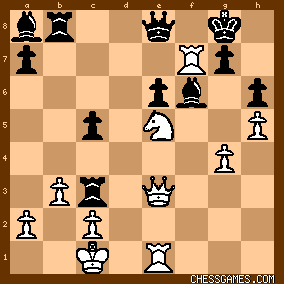
click for larger view31 Qxc3 Qxf7!!
32 Nxf7?? Bxc3!! picks up another piece.
White can both step out of the royal skewer and protect Bc3, but I think only with 30 Kb2 Re4!
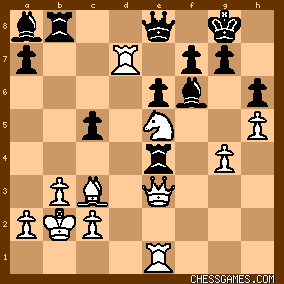
click for larger viewWhite may contain the damage a while with 31 Qd2 but I see nothing else 31 Qg3? Bxe5
32 Bxe5 Rxb3+!
What these sequences show is how dangerous the Rf4 is and how fragile white's queenside pawn position is, despite first impression of solidity. Seen in this light, 29 Qxf4! Bg5 30 Qxg5 hxg5 31 Rxf7 is just as much about keeping white's queenside defence together as it is about picking up the odd pawn. |
|
| Sep-18-10 | | RandomVisitor: After 29.Qxc5:
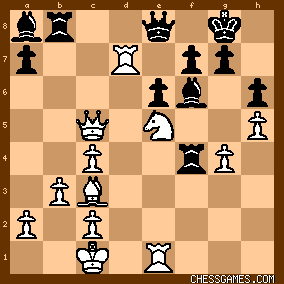
click for larger view Rybka 4 x64:
<[+2.22] d=21 29...Rb7> 30.Rxb7 Bxb7 31.Qxa7 Be4 32.Rd1 Bh4 33.a4 Rf2 34.Rd2 Rxd2 35.Bxd2 Bf6 36.Nd7 Qd8 37.a5 Bc6 38.Nxf6+ Qxf6 39.Kb1 Be4 40.a6 Qf1+ 41.Kb2 Qd1 42.Qb8+ |
|
Sep-18-10
 | | Jimfromprovidence: White definitely should have played 32 Rf2, seeing 32...Rb8 33 Ng6, below.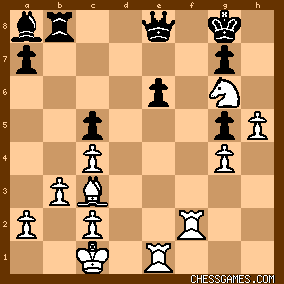
click for larger view The threat is Rf8+, winning back the queen and ending up at least a couple of pawns ahead. There are many variations to consider and they all look good for white. For example, something like 33...Rd8 34 Rf8+ Qxf8 35 Nxf8 Rxf8 36 Rxe6 gives white a solid advantage.

click for larger view |
|
Sep-18-10
 | | al wazir: <PawnEnding: 29. Rxf7 Bxe5 30. Qxe5 Qxf7 31. Qxb8+ Qf8" -- does not 30. - Rxf7 win a rook for Black?> Right. OK, change that to 29. Rxf7 Bxe5 30. Rxf4 Bxf4 31. Qxf4. |
|
| Sep-18-10 | | kevin86: White put the queen in peril,but the resulting simplification left white with a pawn to the good and a won endgame. |
|
| Sep-18-10 | | sethoflagos: <<Jimfromprovidence:> White definitely should have played 32 Rf2, seeing 32...Rb8 33 Ng6, below.> What an interesting puzzle! If white hasn't seen your line, Jim, shouldn't he have played 29 Qxc5? In the game line I'm struggling to find a win after <RandomVisitor:>'s 38...e5. Tends to run into positions like 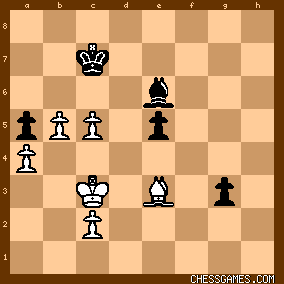
click for larger viewFrom which I can't make much progress |
|
| Sep-18-10 | | kkdogg: Once, thank you. I really enjoy reading your stories. You have a gift. |
|
| Sep-18-10 | | Once: <sethoflagos> Interesting thought. There can be situations when all that is left to you is a sacrificial war - quiet moves just don't work. Following your example, I set Fritzie to analyse the puzzle position but with black to play instead of white. And there certainly seemed to be violence in every line: 29... Re4 30. Qg3 Bxe5 31. Bxe5 Rxe1+ 32. Qxe1 Qxd7 33. Bxb8 29... Bg5 30. Kb2 f6 31. Qxc5 fxe5 32. Qxa7 Bf6 33. Rxe5 Rxg4 34. Rxe6 Qxe6 35. Qxb8+ Kh7 29... Rxc4 30. Nxc4 Bg5 31. Qxg5 hxg5 32.Rxa7
In each case, the silicon monster reckons that the position is levellish, but there's an awful lot of blood on the chessboard. Theoden: I will not risk open war.
Aragorn: Open war is upon you whether you would risk it or not. |
|
| Sep-18-10 | | Funicular: I went right away for Qxf4, Qxg5 and Rxf7. I mean, i saw it, its logical, it keeps white truly active in the K-Side and black has not really much to do, but (and here's why i'm not a GM) I fail to see a clear way after that. I reckon it's active, and we all know that "tactics flow from a superior position" but I fail to see clear tactics. Say black doesn't give the queen back for my R+N. Then I guess I'd be screwed. So I guess even though I see the combination, i wouldn't play it OTB. It looks quite flashy but quite unclear for me. Maybe on a rapid game with no added time I would, but certainly not on a tournament. |
|
| Sep-18-10 | | schroedingers cat: OTB I definetly would play Nxf7 without further thinking. |
|
Sep-18-10
 | | Jimfromprovidence: <sethoflagos> <What an interesting puzzle! If white hasn't seen your line, Jim, shouldn't he have played 29 Qxc5?> That's very difficult to say. The text moves beginning with 29 Qxf4 look forced, so maybe he wanted to simplify as rapidly as possible, taking advantage of superior engame technique? He does have two nice pawn chains after 34...Kxf7.
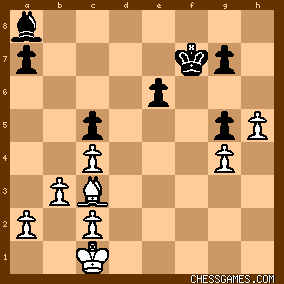
click for larger view |
|
| Sep-18-10 | | rapidcitychess: I got this... Can't say for the right reasons though! :) |
|
| Sep-18-10 | | Fezzik: As I mentioned earlier,
All these people who are trying to solve the OCB ending with their little fishies and stockbirds and so on are missing the basic point of Larsen's play. Larsen saw that the OCB (opposite colored Bishop) ending was winning. Black may not have played optimally, but Larsen knew that White was winning regardless. Keep running your engines on the position, and they might eventually catch up to what Larsen saw when he played 32.Rfe1! |
|
Sep-18-10
 | | Eric Schiller: A wonderful reminder that humans are still superior to engines when it comes to evaluating endgames. I tell my students: if you think the endgame might be winning, go for it! |
|
| Sep-18-10 | | RandomVisitor: <Fezzik>Perhaps you can add some perspective here to those of us who don't know our endings as well as we should. In Benko-Fine Basic Chess Endings, page 195, we have: "We can distinguish five cases in which an ending with bishops of opposite color [and pawns] can be won with an advantage of one pawn or a superior position. In all except the last it is essential to have pawns on both sides of the board. 1. The king is better placed.
2. The passed pawns are qualitatively superior (two passed pawns against one). 3. There is one passed pawn and sufficient play on the other wing. 4. The pawns are better placed (all the defender's pawns are on the same color as his bishop and the attacker has the initiative). 5. Special combinations."
What case do we appear to have here? Perhaps case 2? Thanks. |
|
| Sep-18-10 | | Marmot PFL: White has superior pawns, 3 connected pawns, while black's are isolated and much harder to advance as they cannot support each other. |
|
| Sep-18-10 | | sethoflagos: <<Jimfromprovidence>: The text moves beginning with 29 Qxf4 look forced> The more I look at this position, the more 29 Qxc5 improves. If black tries 29.. Rb7, white can launch a withering attack on f7: 29 Qxc5 Rb7
30 Red1 Re4
31 Rxb7 Bxb7
32 Qc7 Ba8
33 Rd7 Re3
34 Bd4 Re4
35 Nf3 e5
36 Bc5 Rf4
37 Be7 ...
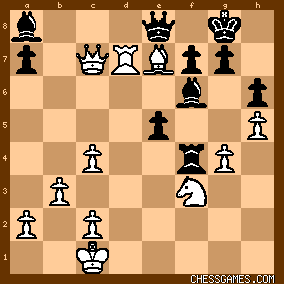
click for larger viewNow black has no sound defence to Rd8, and white's c pawn is very strong. I originally preferred 29..Bxe5, but this falls apart even more quickly to devastating sacrificial attacks. 29 Qxc5 Bxe5
30 Qxe5 Rxg4
31 Rf1 f6
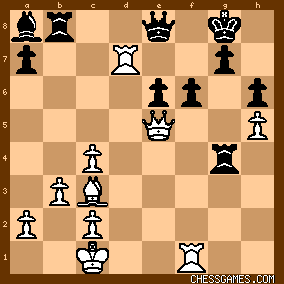
click for larger view32 Rxg7+!! Rxg7
33 Rxf6 Kh7
34 Rxe6 Qf8
35 Qe3 Rd7
36 Qg3 ..
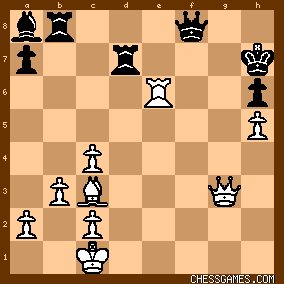
click for larger view36 .. Qg8
37 Qd3+!! Rxd3
38 Re7+ Qf7 (38..Qg7 39 Rxg7+ Kh8 40 cxd3)
39 Rxf7+ Kg8
40 Rg7+ Kf8
41 cxd3 |
|
| Sep-18-10 | | lotlot: Hello, what do you think about:
29 Qxf4 Bg5 30 Qxg5 hxg5
and now instead of: 31 Rxf7 move Red1? |
|
| Sep-18-10 | | agb2002: White has a bishop and a knight for the bishop pair. Black threatens 29... Re4 30.Qf2 Bxe5, etc. and 29... Rxc4 30.bxc4 Bg5. The rook on f4 is defenseless but indirectly protected by the pin. After 29.Qxf4 Bg5 30.Qxg5 hxg5 31.Rxf7 Black does not have anything to oppose the white bishop but the position looks unclear. I don't know. It's too late to attempt a deep analysis. I probably would try 29.Qxc5. |
|
| Sep-18-10 | | toso51: I find it 33...Qxf7 very bad for black! |
|
| Sep-18-10 | | wals: Analysis Rybka 4 x 64:
Black: depth 18 : 4 min
(+2.59):19...Bf6.
Best,
1.  (1.06): 19...Rbd8 20.Ng4 Rxd1+ 21.Rxd1 Ra8 22.Nh6+ Kf8 23.Qg4 g6 24.Qh3 Bf3 25.Re1 Bd8 26.Kb1 Rb8 27.Be5 Qa5 28.Bd6+ Kg7 29.Re3 Qd2 30.Be5+ f6 (1.06): 19...Rbd8 20.Ng4 Rxd1+ 21.Rxd1 Ra8 22.Nh6+ Kf8 23.Qg4 g6 24.Qh3 Bf3 25.Re1 Bd8 26.Kb1 Rb8 27.Be5 Qa5 28.Bd6+ Kg7 29.Re3 Qd2 30.Be5+ f6 White: depth 19: 4 min
(  1.11):20.h4. 1.11):20.h4.
Best,
1.  (2.59): 20.Rd7 Qc8 21.Rfd1[] h6 22.Qh5[] Qe8 23.Rc7[] Bc8 24.Rxa7[] Rb7 25.Rxb7 Bxb7 26.Nd7[] Bxc3 27.Qxc5 Bf6 28.Qxf8+ Qxf8 29.Nxf8 Kxf8 30.c5 Bf3 31.Rd2 e5 32.a4 e4 33.a5 g5 34.c6 e3 35.Rd3 (2.59): 20.Rd7 Qc8 21.Rfd1[] h6 22.Qh5[] Qe8 23.Rc7[] Bc8 24.Rxa7[] Rb7 25.Rxb7 Bxb7 26.Nd7[] Bxc3 27.Qxc5 Bf6 28.Qxf8+ Qxf8 29.Nxf8 Kxf8 30.c5 Bf3 31.Rd2 e5 32.a4 e4 33.a5 g5 34.c6 e3 35.Rd3 Black: depth 13 :
(  1.82):24...h6. 1.82):24...h6.
Best,
1.  (1.60): 24...Rxd1+ 25.Rxd1 Rd8 26.Rxd8+ Bxd8 27.Kb2 Be7 28.h6 g6 29.g4 Qd6 30.Nd3 Bb7 31.g5 Bf8 32.Bf6 a5 33.a4 Qb6 34.Ne5 Bd6 35.Nd7 (1.60): 24...Rxd1+ 25.Rxd1 Rd8 26.Rxd8+ Bxd8 27.Kb2 Be7 28.h6 g6 29.g4 Qd6 30.Nd3 Bb7 31.g5 Bf8 32.Bf6 a5 33.a4 Qb6 34.Ne5 Bd6 35.Nd7 White: depth 19: 5 min:
(  1.15):26.Ba5. 1.15):26.Ba5.
Best,
1.  (2.86): 26.Rxd8+ Rxd8 27.Rg1[] Bxe5 28.Qxe5[] f6 29.Qe3[] e5 30.g5[] hxg5 31.fxg5 f5 32.Bxe5[] Re8 33.Re1[] Be4 34.Bc3[] a5 35.h6 gxh6 36.gxh6 Kh7 37.Qf4 Rg8 38.Bg7 Qb7 39.Qd6 Rc8 40.Rg1 Qc6 41.Qe7 (2.86): 26.Rxd8+ Rxd8 27.Rg1[] Bxe5 28.Qxe5[] f6 29.Qe3[] e5 30.g5[] hxg5 31.fxg5 f5 32.Bxe5[] Re8 33.Re1[] Be4 34.Bc3[] a5 35.h6 gxh6 36.gxh6 Kh7 37.Qf4 Rg8 38.Bg7 Qb7 39.Qd6 Rc8 40.Rg1 Qc6 41.Qe7 2.  (2.83): 26.Rg1 Rxd1+ 27.Rxd1[] Qb7 28.g5 hxg5 29.fxg5 Qe4 30.Qg3 Bxe5[] 31.Bxe5 Rc8 32.h6 Qf3 33.Qg1 Be4 34.Bxg7 Kh7 35.Qe1 Bg6 36.Bf6 Qe4 37.Qd2 Qf5 38.Kb2 Re8 39.Qc3 a6 40.Rd2 Rb8 41.Be5 (2.83): 26.Rg1 Rxd1+ 27.Rxd1[] Qb7 28.g5 hxg5 29.fxg5 Qe4 30.Qg3 Bxe5[] 31.Bxe5 Rc8 32.h6 Qf3 33.Qg1 Be4 34.Bxg7 Kh7 35.Qe1 Bg6 36.Bf6 Qe4 37.Qd2 Qf5 38.Kb2 Re8 39.Qc3 a6 40.Rd2 Rb8 41.Be5 White: depth 21: 10 min:
(=0.00):27.Bc3.
Best,
1.  (1.32): 27.Kb1 Qd6 28.Rd2 Rc8 29.Rxd4 Qxd4 30.Qxd4 cxd4 31.Rd1 Bd8 32.Bxd8 Rxd8 33.g5 hxg5 34.fxg5 f6 35.gxf6 gxf6 36.Rg1+ Kh7 37.Ng4 Rf8 38.c5 f5 39.Ne5 f4 40.c6 Kh6 41.Rd1 f3 42.Rf1 (1.32): 27.Kb1 Qd6 28.Rd2 Rc8 29.Rxd4 Qxd4 30.Qxd4 cxd4 31.Rd1 Bd8 32.Bxd8 Rxd8 33.g5 hxg5 34.fxg5 f6 35.gxf6 gxf6 36.Rg1+ Kh7 37.Ng4 Rf8 38.c5 f5 39.Ne5 f4 40.c6 Kh6 41.Rd1 f3 42.Rf1 2.  (1.29): 27.Rxd4 cxd4 28.Qd2[] Bxe5 29.Rxe5 f6 30.Re1[] e5 31.Kb2 Re8 32.fxe5 fxe5 33.Bb4 Qf6 34.Bc5 Bf3 35.Qd3 Bxg4 36.Bxd4 Bxh5 37.Bc3 Qg5 38.Qd5+ Bf7 39.Qb7 Qe7 40.Qe4 h5 41.Bxe5 (1.29): 27.Rxd4 cxd4 28.Qd2[] Bxe5 29.Rxe5 f6 30.Re1[] e5 31.Kb2 Re8 32.fxe5 fxe5 33.Bb4 Qf6 34.Bc5 Bf3 35.Qd3 Bxg4 36.Bxd4 Bxh5 37.Bc3 Qg5 38.Qd5+ Bf7 39.Qb7 Qe7 40.Qe4 h5 41.Bxe5 Black: depth 20 time 2 hours
(+3.28):27...Rxf4.
Best,
2.  (1.21): 27...Re4 28.Qg1 Rxf4 29.Rd7 Qe8 30.Qxc5 Bxe5 31.Qxe5 Rxg4[] 32.Qd6 Qf8 33.Qxf8+ Rxf8 34.Rxa7 Bf3 35.a4 Rg2 36.a5 Bxh5 37.Rd7 Ra8 38.c5 Kf8 39.b4 Bg6 40.Bd2 Ke8 41.c6 Rd8 42.Rxd8+ Kxd8 (1.21): 27...Re4 28.Qg1 Rxf4 29.Rd7 Qe8 30.Qxc5 Bxe5 31.Qxe5 Rxg4[] 32.Qd6 Qf8 33.Qxf8+ Rxf8 34.Rxa7 Bf3 35.a4 Rg2 36.a5 Bxh5 37.Rd7 Ra8 38.c5 Kf8 39.b4 Bg6 40.Bd2 Ke8 41.c6 Rd8 42.Rxd8+ Kxd8 White: depth 20: 4 min:
(  1.01):32.Ref1. 1.01):32.Ref1.
Best,
1.  (4.00): 32.Rxb7 Bxb7 33.Rd1[] Be4 34.Rd7[] Qc8 35.Kb2[] Kh7 36.Re7 Qd8 37.Rxg7+[] Kxg7[] 38.Nc6+[] Qf6 39.Bxf6+[] Kxf6 40.Nb8[] Kg7 41.Nd7[] Bf3 42.Ne5 Bg2 43.Kc3 Be4 44.Kd2 a6 45.Nd3 Bf3 46.Nf2 (4.00): 32.Rxb7 Bxb7 33.Rd1[] Be4 34.Rd7[] Qc8 35.Kb2[] Kh7 36.Re7 Qd8 37.Rxg7+[] Kxg7[] 38.Nc6+[] Qf6 39.Bxf6+[] Kxf6 40.Nb8[] Kg7 41.Nd7[] Bf3 42.Ne5 Bg2 43.Kc3 Be4 44.Kd2 a6 45.Nd3 Bf3 46.Nf2 2.  (3.54): 32.Rf2 Rc7 33.Ng6 Rc8 34.Re5 Kh7 35.Nf8+ Qxf8[] 36.Rxf8 Rxf8 37.Rxc5 Kh6 38.Bd2 Rf7 39.Rxg5 Kh7 40.Be3 Kg8 41.Kd2 Rd7+ 42.Kc3 Be4 43.h6 Kh7 44.hxg7 Rxg7 45.Re5 Rxg4 46.Rxe6 Kg7 47.Bxa7 (3.54): 32.Rf2 Rc7 33.Ng6 Rc8 34.Re5 Kh7 35.Nf8+ Qxf8[] 36.Rxf8 Rxf8 37.Rxc5 Kh6 38.Bd2 Rf7 39.Rxg5 Kh7 40.Be3 Kg8 41.Kd2 Rd7+ 42.Kc3 Be4 43.h6 Kh7 44.hxg7 Rxg7 45.Re5 Rxg4 46.Rxe6 Kg7 47.Bxa7 Black: depth 22: 2 min:
(  3.57):41...axb5 3.57):41...axb5
Best,
1.  (1.14): 41...g4 42.Bf2 Ke5 43.Ke3 Kf5 44.c5 e5 45.c4 Ke6 46.Kd3 Bg2 47.Bg3 Bf1+ 48.Kc3 Bg2 49.bxa6 Bc6 50.a7 Kd7 51.a5 Ke6 52.Kd3 Bb7 53.Ke3 Ba8 54.a6 Bc6 55.Kd2 Ba8 56.Kd3 Bc6 (1.14): 41...g4 42.Bf2 Ke5 43.Ke3 Kf5 44.c5 e5 45.c4 Ke6 46.Kd3 Bg2 47.Bg3 Bf1+ 48.Kc3 Bg2 49.bxa6 Bc6 50.a7 Kd7 51.a5 Ke6 52.Kd3 Bb7 53.Ke3 Ba8 54.a6 Bc6 55.Kd2 Ba8 56.Kd3 Bc6 2.  (1.14): 41...Ke5 42.Bf2 g4 43.Ke3 Kf5 44.c5 e5 45.c4 Ke6 46.Kd3 Bg2 47.Bg3 Bf3 48.bxa6 Bc6 49.a7 Ba8 50.a5 Bc6 51.Kc3 Ba8 52.a6 Bc6 53.Kd2 Ba8 54.Kd3 Bc6 55.Ke3 g6 56.Kd3 Ba8 (1.14): 41...Ke5 42.Bf2 g4 43.Ke3 Kf5 44.c5 e5 45.c4 Ke6 46.Kd3 Bg2 47.Bg3 Bf3 48.bxa6 Bc6 49.a7 Ba8 50.a5 Bc6 51.Kc3 Ba8 52.a6 Bc6 53.Kd2 Ba8 54.Kd3 Bc6 55.Ke3 g6 56.Kd3 Ba8 Black: depth 21:
(+10.81):43...g4.
White played 44.Ke3, +6.39, best was,
1.  (10.82): 44.a5 Bb7 45.Ke3 g3 46.a6 g2 47.Kf2[] Bc8 48.Kxg2[] Ke4 49.Bf8[] e5[] 50.c5 Kd5[] 51.Kg3[] Kc4 52.c6 Kxb5 53.a7 Kxc6 54.a8Q+[] Bb7 55.Qe8+[] Kb6[] 56.Qxe5 Bc6 57.Qb8+ Bb7 58.Bc5+ Kb5 59.Qxb7+ (10.82): 44.a5 Bb7 45.Ke3 g3 46.a6 g2 47.Kf2[] Bc8 48.Kxg2[] Ke4 49.Bf8[] e5[] 50.c5 Kd5[] 51.Kg3[] Kc4 52.c6 Kxb5 53.a7 Kxc6 54.a8Q+[] Bb7 55.Qe8+[] Kb6[] 56.Qxe5 Bc6 57.Qb8+ Bb7 58.Bc5+ Kb5 59.Qxb7+ |
|
| Sep-18-10 | | Eduardo Leon: I must be too idiot. I could not solve today's puzzle. |
|
| Sep-19-10 | | patzer2: For yesterday's Saturday puzzle solution, the winning Queen sham sacrifice 29. Qxf4! was set up by the essential preparatory move 28. Rd7! After 28. Rd7! Qe8 29. Qxf4! Bg5 30. Qxg5 hxg5 31. Rxf7  , Larsen sees he picks up even material for the "Queen sacrifice," but he also gets a likely winning bonus in the five weak isolated Black pawns he creates to target. Without any deeper calculation, Larsen realizes he has all the winning chances and Black will be fighting for a difficult and likely impossible draw in practical OTB competition. , Larsen sees he picks up even material for the "Queen sacrifice," but he also gets a likely winning bonus in the five weak isolated Black pawns he creates to target. Without any deeper calculation, Larsen realizes he has all the winning chances and Black will be fighting for a difficult and likely impossible draw in practical OTB competition. Interestingly, if one is looking for "perfect play," the computers find as <RV> points out that after 31...Rb7!, White needs to play 32. Rff1!  to find the surest and strongest win. to find the surest and strongest win. Indeed, in the followup, with <RV>'s 38...e5 or, in place of the weak 41...axb5? pointed out by <paul1959>, 41...e5 or 41...g4 Black puts up much more resistance and appears to have good practical drawing chances. Perhaps against "perfect play" by his opponent, Larsen wouldn't still be winning with his "weaker" followup 32. Rfe1?!  (instead of 32. Rff1! (instead of 32. Rff1!  ). ). Yet in the actual game between these two human players, with the clock ticking, and the great Dane bearing down with all the winning chances, it's little surprise his opponent finally cracked under the pressure with 41...axb5?, whereupon Grand Master Bent Larsen gave his opponent and the world a lesson in how humans really play winning Chess. P.S.: Essentially, 28. Rd7! Qe8 29. Qxf4! Bg5 30. Qxg5 hxg5 31. Rxf7  is a surprise demolition of Black's pawn structure. is a surprise demolition of Black's pawn structure. |
|
 |
|
< Earlier Kibitzing · PAGE 2 OF 2 ·
Later Kibitzing> |





